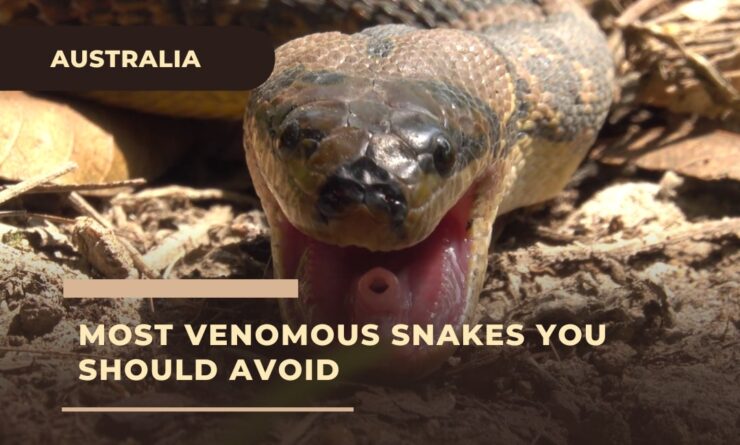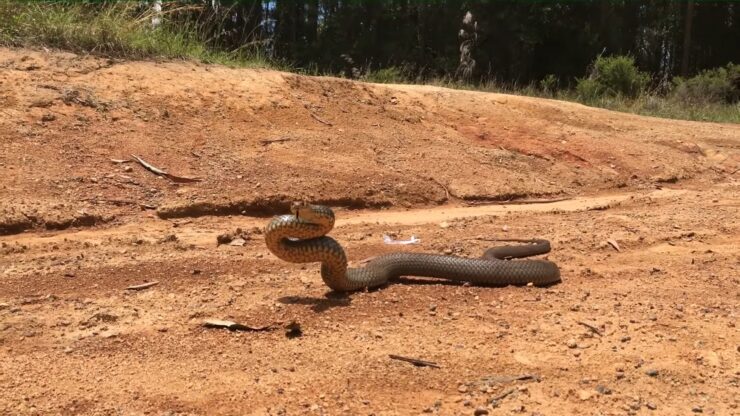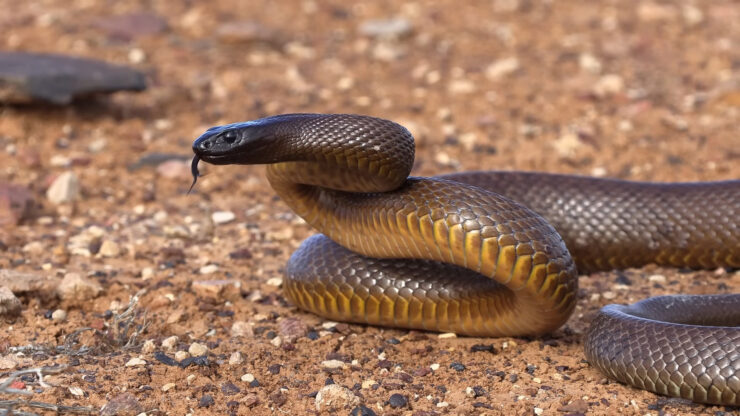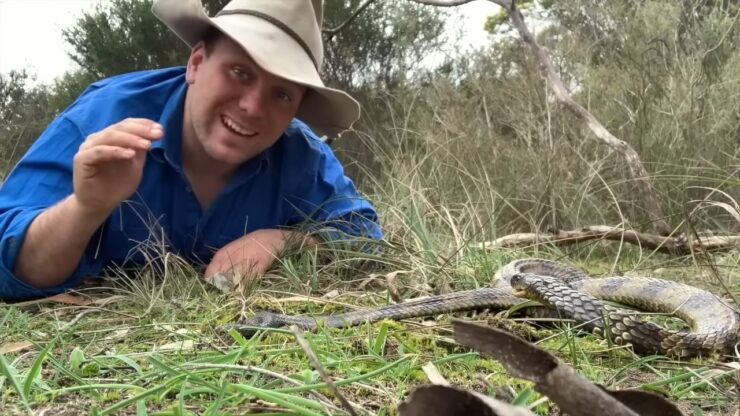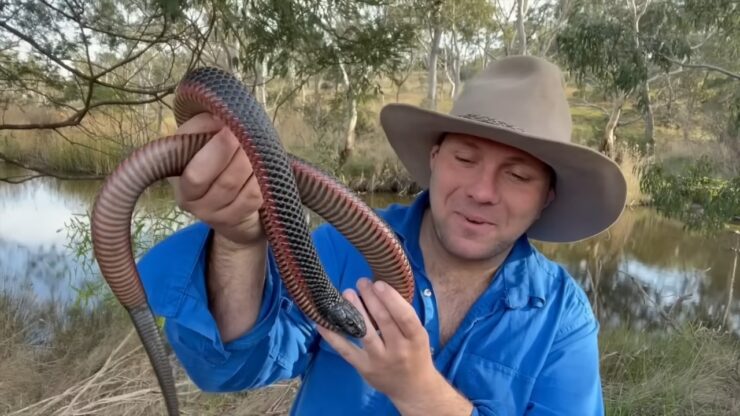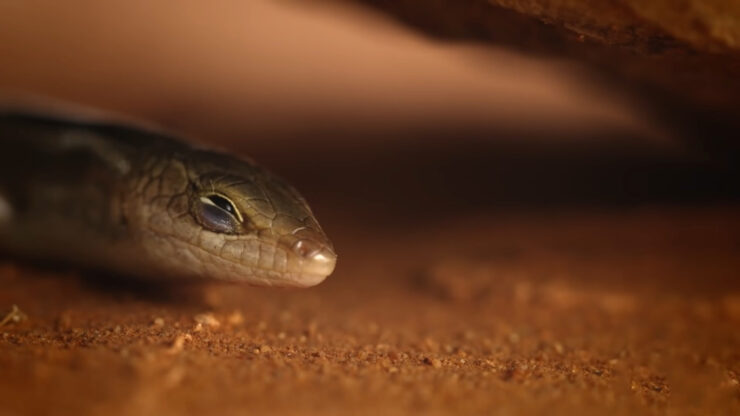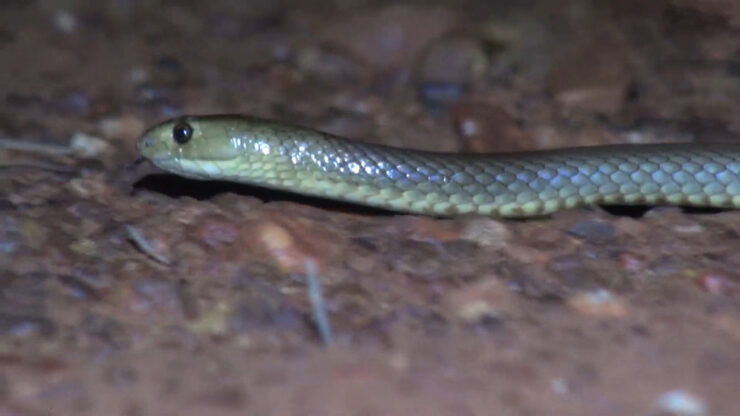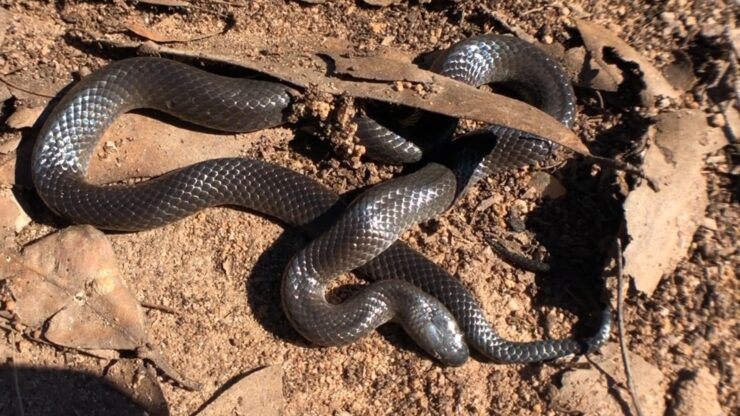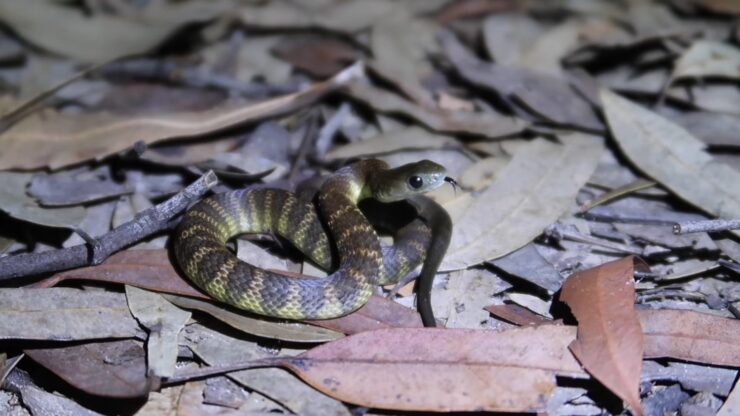Australia is a land of diverse and fascinating wildlife, and its snake population is no exception. With 66 recognized species of venomous snakes, the continent is home to some of the most toxic serpents in the world. However, venom potency does not directly equate to danger. Factors such as the snake’s behavior and habitat significantly influence the threat level to humans.
While some of these snakes possess incredibly potent venom, they are generally not aggressive towards non-prey creatures, including humans. This article will introduce you to the top 10 venomous snakes of Australia, exploring their physical characteristics, venom potency, and geographic distribution.
1. Eastern Brown Snake (Pseudonaja textilis)
The Eastern Brown Snake is a slender species, with most adults falling within the 6-foot (1.8 meters) range. Some specimens can reach up to 7.5 feet (2.2 meters). This snake is known for its distinctive behavior of raising its head when attacking or defending, which often results in human bites occurring on the upper thigh.
Possessing the second most powerful venom in the world based on median lethal dose (LD50) values, the Eastern Brown Snake’s bite is incredibly toxic. Symptoms can start with headaches within 15 minutes and escalate to possible cerebral hemorrhage or heart attack within an hour.
It is commonly found in suburbs and farmlands, where its favorite prey, the introduced house mouse, is abundant. Its preference for warmer, drier areas means its range doesn’t overlap significantly with the cane toad, and therefore its population remains relatively stable.
2. Inland Taipan (Oxyuranus microlepidotus)
The Inland Taipan, also known as the fierce snake, is not named for its demeanor but for its deadly bite. Adults typically measure approximately 6 feet (1.8 meters), but larger specimens can approach 9 feet (2.7 meters).
The venom of the Inland Taipan is the most potent of any reptile in the world. It is more than twice as deadly to mammals as the next contender, a sea snake, and six times as powerful as the Eastern Brown Snake, which has the second most potent venom of any land one.
Inhabits the remote arid areas of inland Eastern central Australia. Its relatively docile nature combined with its remote habitat means human bites are extremely rare. Almost all known Inland Taipan bites in the last 40 years have been to professional snake handlers.
3. Coastal Taipan (Oxyuranus scutellatus)
The Coastal Taipan is the second longest venomous snake in Australia, commonly growing to more than 6.5 feet (1.9 meters), with a recorded maximum length of 9.5 feet (2.8 meters). It is closely aligned with Africa’s black mamba in toxin power, hunting behavior, size, and shape.
The Coastal Taipan’s venom is the third most powerful of any land snake. When surprised, the snake is known to launch itself at its target and deliver multiple quick bites. Before the late 1950s, when an effective antivenin became available, nearly all bites were fatal and could occur in as little as 60 minutes.
Common along the eastern coast, the Coastal Taipantends prefer sugar cane fields and other agricultural settings. It has a large range along the eastern portion of Australia, and a subspecies is found in New Guinea. The Coastal Taipan is not found in areas where winter temperatures drop below the mid-60s Fahrenheit (17.2 to 18.3 degrees Celsius). They are primarily sight hunters that appear to be most active during mornings but have been observed hunting nocturnally during hot and dry weather.
- If you want to read more articles on Snakes check here.
5. Tiger Snake (Notechis spp.)
The Tiger is a stout species with a typical length of about 4 feet (1.2 meters). Its coloration can be highly variable, including the absence of tiger-like striping, which sometimes leads to misidentification.
They account for a significant percentage of reported snake bites in Australia, with untreated fatality estimates at about 50 percent. Its venom is potent and can cause considerable damage.
They are found all around the coastline of Australia and prefer extremely wet habitats. They are strong swimmers and have also been observed climbing trees.
6. Death Adder (Acanthophis spp.)
The Common Death Adder is a stout, relatively short snake, typically measuring 2-3 feet (.60 to .90 meters). It features long fangs rivaling the Coastal Taipan and has the fastest strike in Australia.
The venom of the Common Death Adder isn’t among the most potent in Australia, but it would rank very high anywhere else. Before the development of antivenin, about half the people bitten would be expected to die, often from paralysis and respiratory failure within two hours of being bitten.
The Common Death Adder is currently in decline due to predation by the invasive cane toad. It is an ambush hunter that hides in leaf litter and another cover, making it easy to accidentally step on or kick.
7. Red-bellied Black Snake (Pseudechis porphyriacus)
The Red-bellied Black is a moderately-sized snake, typically about 4 feet (1.2 meters) in length, with rare instances exceeding 8 feet (2.4 meters). It is commonly encountered by people, even in urban settings, and is the primary source of snakebites among dogs in Australia.
While there are no human deaths attributed to the Red-bellied Black Snake, serious bites have required more than a week of recovery even with antivenin, and have resulted in amputations.
Red-bellied Black live along the Eastern coast of Australia and prefer wet, marshy areas or ponds as they prey primarily on frogs, fish, others, and sometimes small rodents.
8. Mulga Snake (Pseudechis australis)
The Mulga, also known as the King Brown, is the largest of Australia’s venomous snakes. It can grow to more than 11 feet (3.3 meters), primarily in the more northern areas of its reach. Its coloration can vary from very dark, nearly black to light tan which highlights a reticulated pattern.
its venom is relatively mild (in Australian terms) and quite survivable when black antivenins are introduced within a few hours. However, they typically strike repeatedly and frequently “chew” to deeply envenom targets. It also has a massive amount of venom, by some measures the largest payload of any venomous snake in the world.
It has an extremely wide and varied range. It can be found in almost every habitat in Western and Central Australia except the wettest areas. It overlaps range with the Eastern Brown, adding to misidentification.
9. Western Brown (Pseudonaja nuchalis)
The Western Brown is a long and thin species, with typical lengths of about 5 feet (1.5 meters) and some specimens reaching up to about 7 feet (2.1 meters). It is very fast and is primarily an afternoon and evening hunter.
Although its venom isn’t as potent as the Eastern Brown, the Western Brown Snake typically produces three times the dose of its still toxic venom. Immediate treatment is required as the venom can be fatal to humans.
The Western Brown Snake has an extremely wide and varied range. It can be found in almost every habitat in Western and Central Australia except the wettest areas. It overlaps range with the Eastern Brown, adding to misidentification.
10. Copperhead (Austrelaps spp.)
The Lowland Copperhead is a moderate-sized elapid with typical lengths of 3 to 4 feet (0.9 to 1.2 meters) and highly variable coloration from reddish rust to tan, near black, or even yellow.
The Lowland Copperhead is responsible for more than a dozen confirmed bites and a fatality in recent years. Its venom is potent and can cause considerable damage.
The Lowland Copperhead prefers wetter habitats in the extreme southeastern areas of Australia and nearby southern islands. Its preferred prey is snakes, frogs, and lizards that it tends to hunt along the edges of waterways.
11. Small-eyed (Cryptophis spp.)
The Eastern Small-eyed is a smaller species, averaging less than 2 feet in length (0.60 meters), with larger specimens hitting as much as 4 feet (1.2 meters). It gives live birth to a handful of babies and preys almost exclusively on other reptiles.
The Eastern Small-eyed venom isn’t among the most deadly and may result in few or even no symptoms. However, the myotoxin venom is very slow acting and has caused death from muscle (primarily heart) damage that can surface as much as a week after the bite.
The Eastern Small-eyed Snake has a large range along the Eastern coastal range. It is a nocturnal hunter that employs both active searchings for resting diurnal prey and ambush hunting.
12. Stephen’s Banded (Hoplocephalus Stephens)
Unfortunately, there is no detailed information about Stephen’s Banded Snake in the provided source. However, it is known that this species is native to Australia and is a member of the family Elapidae, which includes many venomous species.
The venom potency and effects of Stephen’s Banded are not specified in the provided source. However, as a member of the Elapidae family, it is likely venomous and could potentially pose a threat to humans if encountered.
The geographic distribution of Stephen’s Banded is not specified in the provided source. Further research would be required to provide accurate information on this topic.
- If you want to read more articles on Australia check here.
FAQs
How can I identify different venomous snakes in Australia?
Identifying venomous snakes in Australia can be challenging due to their diverse appearances. However, certain physical characteristics can help. For instance, the Eastern Brown is slender and often raises its head when threatened. The Inland Taipan is typically about 6 feet long, while the Coastal Taipan is one of the longest venomous in Australia. The Tiger has variable coloration, including tiger-like striping, and the Death Adder is a stout, relatively short snake with long fangs.
Where are these venomous snakes found?
These venomous snakes are found in various habitats across Australia. The Eastern Brown is common in suburbs and farmlands, while the Inland Taipan inhabits remote arid areas of inland Eastern central Australia. The Coastal Taipan is common along the eastern coast, and the Tiger is found all around the coastline of Australia. The Death Adder is currently in decline due to predation by the invasive cane toad.
What are the effects of the venom of these snakes?
The venom of these snakes can have severe effects on humans. The Eastern Brown Snake’s venom can cause symptoms ranging from headaches to possible cerebral hemorrhage or heart attack. The Inland Taipan’s venom is the most potent of any reptile in the world, and the Coastal Taipan’s venom is the third most powerful of any land one. The Tiger venom can cause considerable damage, and the Death Adder’s venom can cause paralysis and respiratory failure.
What precautions should I take to avoid snake bites in Australia?
To avoid bites in Australia, it’s important to be aware of your surroundings, especially in areas known to be inhabited by snakes. Avoid walking through long grass and undergrowth where they may be hiding. If you encounter it, do not attempt to handle or provoke it. Instead, back away slowly and let the snake move away. If you are bitten, seek medical attention immediately.
Are there any recent reports or studies about venomous snakes in Australia?
Yes, there are ongoing studies and reports about venomous in Australia. For instance, a recent report by Snake Catcher Noosa found that statistically, there is a snake in 1 in every 3 roof spaces in the state. This highlights the importance of being aware of the potential presence of snakes even in urban and suburban areas.
What should I do if I’m bitten by a venomous snake?
If you’re bitten by a venomous snake in Australia, it’s crucial to seek medical attention immediately. While waiting for medical help, try to remain calm and still to prevent the venom from spreading through your body. Do not attempt to suck the venom out or apply a tourniquet. Instead, apply a pressure bandage over the bite site and immobilize the limb with a splint if possible. Remember the snake’s appearance to help identify the species for treatment.
Conclusion
Australia is home to a diverse array of venomous snakes, each with its unique characteristics, venom potency, and geographic distribution. From the Eastern Brown Snake, with the second most powerful venom in the world, to the Inland Taipan, the most venomous of all reptiles, these creatures are a testament to the rich biodiversity of the continent.
However, it’s important to remember that these snakes, while potentially dangerous, are a vital part of the ecosystem and should be respected rather than feared. Awareness and understanding of these creatures can help ensure safety for both humans and their alike.
Australia’s venomous snakes are a fascinating subject of study, offering valuable insights into the world of herpetology and the intricate balance of nature.

